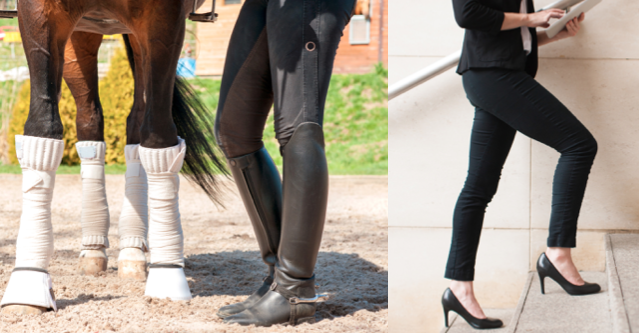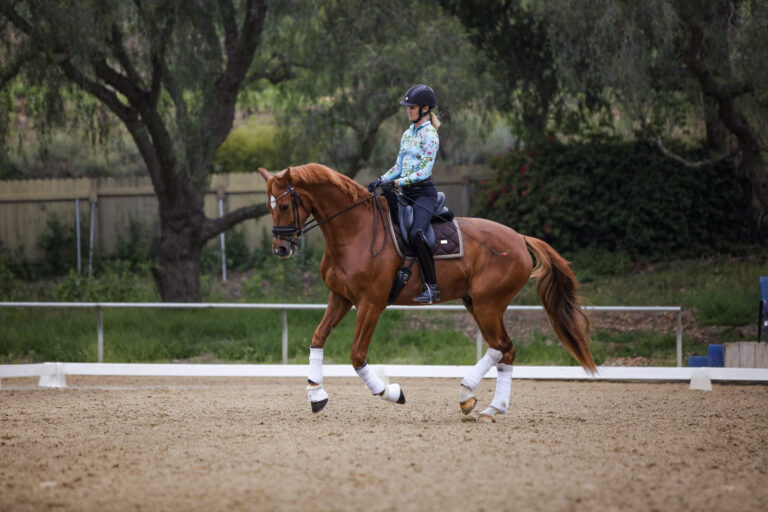Q: I have shown and trained on my own for many years. As I’ve moved up the levels, no local instructors offer what I’m looking for. They either demand too much commitment from students in show attendance, lessons and/or full training for the horse at their facility. I simply cannot afford the time or money to do what they require. I have two small children at home and I work part-time, so traveling the hours to get to a lesson isn’t in the cards either. I feel it’s unfair to continue to train and compete without a good set of eyes on the ground. I’m heartbroken but don’t see any alternatives. Do you have any suggestions?
—Name withheld by request
A: Dressage is no easy undertaking in the best of circumstances. Pursuing this discipline with the pressures of a career and the needs of a family can be enough to push anyone over the edge. The typical dressage rider’s personality profile is one of determination, courage, diligence, perfectionism, competitiveness and no aversion to risk (despite our reputation from the jumper riders). Let’s face it: Owning a horse is a high-risk venture and just getting on could be life-threatening. These personality qualities typically carry over from the dressage world into respective careers and family households. High standards and expectations combined with multiple potentially conflicting demands can be a recipe for unhappiness. If you are like me, a big part of happiness is directly related to the sense of being able to do a good job. This is where some basic concepts can be helpful in managing the juggling act.

Start with your current situation and an accurate assessment of your strengths and weaknesses. You write that you aren’t able to find a local trainer capable of meeting your needs and respecting your other commitments. I am a big believer in having access to quality training so I would encourage you to build into your schedule the pillars that will support your progress.
You need mobility so you can get to a training establishment within a reasonable distance at least a few times a month to give you the necessary feedback and all-important training course corrections. Bring your video camera, stick it on a tripod, or get someone to film you, and discipline yourself to watch it. You can train your eye and may be surprised by what you see. Most good trainers that I know will work with you on this. They understand how hard and important it is to have consistent training. Your horse trailer can be equipped with a comfortable and warm space for your child to wait for you in safety, perhaps watch a video and have a little rest in a sleeping bag while you have your lesson. Again, a lot depends upon your children and their ages, but barns can be good environments for them to learn to be safe, considerate, respectful and, dare I say, helpful.
Think out of the box. Conrad Schumacher would tell us stories of being a young boy working for the late German Olympian Josef Neckermann (an awesome role model for the multitasking dressage rider). Conrad and a number of other young aspirants would stand in the corners of the arena and muster the courage to tell Neckermann whether he had his horse straight. They would get some coins for their vigilance, and it sounded like a fun game, although I am sure Neckermann was deadly serious about dedication and personal discipline. Do you know any kids interested in making some pocket money?
You can also organize a regular clinic with a trainer who is compatible with you and your needs. This can be a great opportunity to both access excellent consistent training on your terms and to synergize with your local riding community and build a supportive network with other riders. Training together under the same clinician will mean that you will be working together with other like-minded riders who can be an eye on the ground for you (and vice versa) during the training time between clinics.
Don’t be stuck on one discipline. You can bring together riders for your clinics from diverse backgrounds. As a clinician myself, I enjoy working with all sorts of different riders and horses. I regularly delight in teaching jumper riders dressage, and I was recently thrilled to ride an endurance horse that had logged over 10,000 miles. At 18 years, he was supple, balanced, elastic and unbelievably fit. Good horses and sensitive, committed riders come in every age, shape and type. The additional bonus here is that these same riders may be able to help you out when you are in a tight spot by keeping your horse going for you when other duties call you away.
This brings me to my next point. Flexibility, adaptability and creativity are crucial survival techniques for the multitasking dressage rider. Always try to transform challenging circumstances into an opportunity. Your talented young prospect is off due to splints, abscesses, etc. Is there someone you trust to whom you could delegate the daily care so that you can focus on the other priorities you have to contend with? Are there capable and trustworthy riders at your barn who can hack your horse or do some cross-training, such as modest gymnastic jumping grids or some conditioning work on hills, a few times a week? Most dressage riders’ sense of responsibility overrides their ability to delegate and have other people step in to help them. If you can get some help with the grooming, tack cleaning and other tasks associated with your horse’s care, you can optimize your available time to the essentials.
I feel incredibly lucky that I have been able to combine my love of horses with my current line of work in real estate. All the years as a professional trainer have given me great patience and determination, negotiation skills, competitive skills and a work ethic like no other. My son has grown up in barns, riding arenas, stalls and horse trailers, but he also happily attends open houses and helps me fix the copy machine under a contract deadline. He is also quick to point out if my shoes aren’t quite right for my suit! It is incredible for kids to interface with real-world situations and learn by doing things and participating in their parents’ lives. As you know, it is far from easy and, indeed, there are times when we feel stretched so thin that emergency triage may be the only salvation. Then, like a good manager, you must quickly analyze your highest priorities, break the big problems into digestible pieces ranked in order of time sensitivity and roll with it.
Read practical materials with good pictures, such as Dressage Today, and utilize online videos. Even if it might be far more advanced than your actual level, the visual imprinting is very beneficial.
Know you are not alone. There are many good role models out there. Olympic dressage rider Charlotte Bredahl Baker has always been an inspiration for me because she rode in the Olympics, trained her own horses, is a licensed realtor, has a lovely family and is very involved in the community. Remember to keep it joyful and light. Despite the seriousness of some situations and all the responsibilities, you must enjoy the journey!
This article first appeared in the January 2012 issue of Dressage Today magazine.
Shelley Lawder
is a USDF gold medalist, a Certified Instructor through Fourth Level and a Canadian Coach III, who has trained and competed successfully for more than 20 years. She works to balance her real estste business with dressage and her family. She is based in Vancouver, British Columbia.











